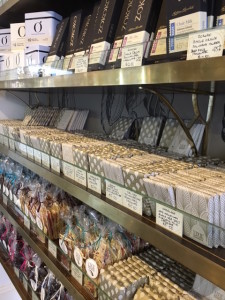More often than not, we read and hear about chocolates referenced with phrases and words such as “guilty pleasure”, “sweet treat”, “decadent”, “morish”, “sugar fix”, “addictive”, “calorie rich”, “fattening” and the list goes on. Recently, I stumbled upon an article that opposes this train of thought; an interesting read and points to ponder for chocoholics and cynics alike.
Amidst all the negative press, can chocolates really be good for us? According to the article and research behind the findings, most certainly!
Putting my scientist’s hat (and coat) on, I shall attempt to demystify the health-promoting properties of chocolates, which give rise to the claimed benefits in the article including “better cognitive function” and “good for the heart and circulation, reduces risk of stroke, reduces cholesterol, and protects the skin against sun damage”.
Chocolates are generally made of a combination of cocoa solids, cocoa butter and sugar. The origins of the cocoa solids and cocoa butter are cocoa beans. The beans, in turn, contain:
- Flavanoids: Plant-based antioxidants in the form of flavanols, including catechin and derivatives, and B2, B3 and C1 procyanidins. It is these flavanols that are theorised to induce the health benefits of improved cognitive, heart and circulatory function, and to lower blood pressure and cholesterol
- Methylxanthines: Namely naturally occurring theobromine, caffeine and theophylline. These compounds act on adenosine receptors in the central nervous system to enhance arousal, mood, and concentration levels
- Vitamins and minerals: Including Vitamins A, B1, B2, B3, B12 and E, and minerals such as calcium, magnesium, iron, phosphorus and zinc
The percentage on the labels of some chocolates, for example 45%, 65% and 99%, is the amount of combined cocoa solids and cocoa butter in the chocolate, relative to its sugar content. A 65% chocolate contains 65% of cocoa (solids and butter) and 35% sugar. The proportion of cocoa solids to cocoa butter varies from manufacturer to manufacturer. And the higher the cocoa solids content, the darker the colour of the chocolate. White chocolate does not contain cocoa solids, hence the lack of colour. Instead, other ingredients such as milk, milk powder, cream and butter are added to give white chocolate its characteristic flavour and mouthfeel. This also applies to milk chocolate.
What does all this mean, you may ask? Simply put, next time you crave chocolate…..give in to the craving, in moderation of course. And choose dark, over milk or white, to reap the health benefits of chocolate.
 Tucked away in a quiet alley, a short stroll from the bustling Puerta Del Sol, Chocolateria St Gines is touted to be THE place for the quintessential Spanish treat of chocolate con (with) churros in Madrid; a discovery that we made after the fact. Eaten for breakfast, tea, dessert, supper or anytime really. Admittedly, we followed our noses, tracing the origins of the heavenly, sweet aroma of freshly fried dough. The outdoor table settings, on either side of the entrance, were already fully occupied that morning. People young and old were enjoying their chocolate con churros while lapping up the unseasonably warm weather in May, and people watching. We joined the back of the queue at the marble counter, entertained by the chef frying up foot long churros and porras (thicker version) to military precision. At the other end of the counter, white coffee cups and saucers were neatly laid out, ready to be filled. The menu was simple – churros, porras, hot chocolate, cafe con leche (coffee with milk) and other beverages.
Tucked away in a quiet alley, a short stroll from the bustling Puerta Del Sol, Chocolateria St Gines is touted to be THE place for the quintessential Spanish treat of chocolate con (with) churros in Madrid; a discovery that we made after the fact. Eaten for breakfast, tea, dessert, supper or anytime really. Admittedly, we followed our noses, tracing the origins of the heavenly, sweet aroma of freshly fried dough. The outdoor table settings, on either side of the entrance, were already fully occupied that morning. People young and old were enjoying their chocolate con churros while lapping up the unseasonably warm weather in May, and people watching. We joined the back of the queue at the marble counter, entertained by the chef frying up foot long churros and porras (thicker version) to military precision. At the other end of the counter, white coffee cups and saucers were neatly laid out, ready to be filled. The menu was simple – churros, porras, hot chocolate, cafe con leche (coffee with milk) and other beverages. We settled on one serve of the churros. They arrived on our table as 5 even-lengthed, golden brown and warm batons, with beautifully formed ridges. The chocolate was served in a white coffee cup, warm, molten and dark, with a teaspoon to scoop up the viscous treat. After the obligatory photos by hubby, I dunked the churro into the molten chocolate and took my first bite. The initial taste sensation that hit me was the chocolate – warm but not scorching, rich and bold in flavour, and alternating between sweet and bitter on my taste buds. It coated my palate as I sank my teeth into the ridged outer surface of the churro. Crisp on the outside, light and fluffy on the inside, and mildly sweet, the churro was an example of perfectly cooked choux pastry. In that moment, I was completely immersed in savouring my Spanish chocolate con churros experience……The simple pleasures in life……
We settled on one serve of the churros. They arrived on our table as 5 even-lengthed, golden brown and warm batons, with beautifully formed ridges. The chocolate was served in a white coffee cup, warm, molten and dark, with a teaspoon to scoop up the viscous treat. After the obligatory photos by hubby, I dunked the churro into the molten chocolate and took my first bite. The initial taste sensation that hit me was the chocolate – warm but not scorching, rich and bold in flavour, and alternating between sweet and bitter on my taste buds. It coated my palate as I sank my teeth into the ridged outer surface of the churro. Crisp on the outside, light and fluffy on the inside, and mildly sweet, the churro was an example of perfectly cooked choux pastry. In that moment, I was completely immersed in savouring my Spanish chocolate con churros experience……The simple pleasures in life…… The name Kakawa, according to chocolatier and co-owner Jin Sun Kim, derives its origin from the French word “cacao” (pronounced ka-kow). Jin Sun was on hand to greet her customers and share her passion for her trade. There were choices aplenty for the die-hard chocoholics; the showcase was filled with row after row of beautiful hand-made chocolates and the surrounding shelves were decked out with multiple selections of solid chocolates and Easter treats. To top it off, one had a direct view into the open kitchen, from the shopfront, where Jin Sun’s team was in the process of hand-crafting more tantalising creations. My eyes honed in on their Easter special, the filled quail eggs. Artistic, glossy and petite filled eggs with five different flavours. Check out the photo on the left. To date, I’ve savoured the white chocolate sea salted caramel, dark chocolate blueberry and milk chocolate caramelised coconut and cashew eggs. The blueberry egg ranks as my favourite, with a marshmallow textured centre, flavoured with strong accents of blueberry and covered in a crisp dark chocolate shell.
The name Kakawa, according to chocolatier and co-owner Jin Sun Kim, derives its origin from the French word “cacao” (pronounced ka-kow). Jin Sun was on hand to greet her customers and share her passion for her trade. There were choices aplenty for the die-hard chocoholics; the showcase was filled with row after row of beautiful hand-made chocolates and the surrounding shelves were decked out with multiple selections of solid chocolates and Easter treats. To top it off, one had a direct view into the open kitchen, from the shopfront, where Jin Sun’s team was in the process of hand-crafting more tantalising creations. My eyes honed in on their Easter special, the filled quail eggs. Artistic, glossy and petite filled eggs with five different flavours. Check out the photo on the left. To date, I’ve savoured the white chocolate sea salted caramel, dark chocolate blueberry and milk chocolate caramelised coconut and cashew eggs. The blueberry egg ranks as my favourite, with a marshmallow textured centre, flavoured with strong accents of blueberry and covered in a crisp dark chocolate shell. I couldn’t pass up the opportunity to select several hand-crafted chocolates, which, according to Jin Sun, changes seasonally depending on availability of ingredients. The hot cross truffle, milk chocolate cinnamon flavoured truffle and coated in a layer of milk chocolate, was their rustic take on the hot cross bun. The truffle was sweet, but not to the point of being overly sweet, smooth and the hint of cinnamon was just enough to trick your brain into thinking that you were biting into a hot cross bun. I’ll definitely be back for more soon!
I couldn’t pass up the opportunity to select several hand-crafted chocolates, which, according to Jin Sun, changes seasonally depending on availability of ingredients. The hot cross truffle, milk chocolate cinnamon flavoured truffle and coated in a layer of milk chocolate, was their rustic take on the hot cross bun. The truffle was sweet, but not to the point of being overly sweet, smooth and the hint of cinnamon was just enough to trick your brain into thinking that you were biting into a hot cross bun. I’ll definitely be back for more soon! My first pick was the dark hot cross bun spiced wafers – shards of cinnamon flavoured dark chocolate, dotted with raisins and sultanas. It’s yet again another take on the hot cross bun, and my favourite to date. The cinnamon complemented the strong, bold flavours of the dark chocolate, and the raisins and sultanas added a sweet contrast. Perhaps I’m also a little biased, with my preference towards dark chocolate.
My first pick was the dark hot cross bun spiced wafers – shards of cinnamon flavoured dark chocolate, dotted with raisins and sultanas. It’s yet again another take on the hot cross bun, and my favourite to date. The cinnamon complemented the strong, bold flavours of the dark chocolate, and the raisins and sultanas added a sweet contrast. Perhaps I’m also a little biased, with my preference towards dark chocolate. e selection of white, milk and dark bars. I settled on the 99% Madagascar dark chocolate, a gift for mum-in-law, and the 66% mandarin, orange and lemon in organic Dominican Republic dark chocolate. Lixie also features the creations of the Sydney bean to bar chocolate maker, Zokoko. To the chocoholics in Sydney, give Lixie a go and let me know what you think…..
e selection of white, milk and dark bars. I settled on the 99% Madagascar dark chocolate, a gift for mum-in-law, and the 66% mandarin, orange and lemon in organic Dominican Republic dark chocolate. Lixie also features the creations of the Sydney bean to bar chocolate maker, Zokoko. To the chocoholics in Sydney, give Lixie a go and let me know what you think….. First stop – Belle Fleur Fine Chocolates. With 4 generations of chocolate-making experience under their belts, they definitely know their chocolates! We were not disappointed, with shelves and shelves decked out with Easter hampers of chocolate bunnies, bilbies and eggs, and their every-day range of beautiful, hand-crafted chocolates.
First stop – Belle Fleur Fine Chocolates. With 4 generations of chocolate-making experience under their belts, they definitely know their chocolates! We were not disappointed, with shelves and shelves decked out with Easter hampers of chocolate bunnies, bilbies and eggs, and their every-day range of beautiful, hand-crafted chocolates. The salted caramel filled dark chocolate egg was delectable. The slight bitterness of the dark chocolate complemented the sweet and saltiness of the caramel, resulting in a well balanced treat for the tastebuds. The cute miniature bunnies and bilbies are a sure winner for kids and adults alike. I felt a little indulgent, biting into the dark chocolate Easter bunny. But all was forgotten when the crisp chocolate shell unmasked the silky, smooth hazelnut praline beneath it. Delicious!
The salted caramel filled dark chocolate egg was delectable. The slight bitterness of the dark chocolate complemented the sweet and saltiness of the caramel, resulting in a well balanced treat for the tastebuds. The cute miniature bunnies and bilbies are a sure winner for kids and adults alike. I felt a little indulgent, biting into the dark chocolate Easter bunny. But all was forgotten when the crisp chocolate shell unmasked the silky, smooth hazelnut praline beneath it. Delicious! Sticking with the Easter theme, we hopped next door to Victoire bakery, discovering their hot cross bun with a twist. The hot “croissant” bun – comprising layers of flaky croissant pastry, sitting atop a traditional hot cross bun. In theory, an interesting combination. The croissant layer was flaky, but sadly, the bun was a tad dry. A creative effort though.
Sticking with the Easter theme, we hopped next door to Victoire bakery, discovering their hot cross bun with a twist. The hot “croissant” bun – comprising layers of flaky croissant pastry, sitting atop a traditional hot cross bun. In theory, an interesting combination. The croissant layer was flaky, but sadly, the bun was a tad dry. A creative effort though.